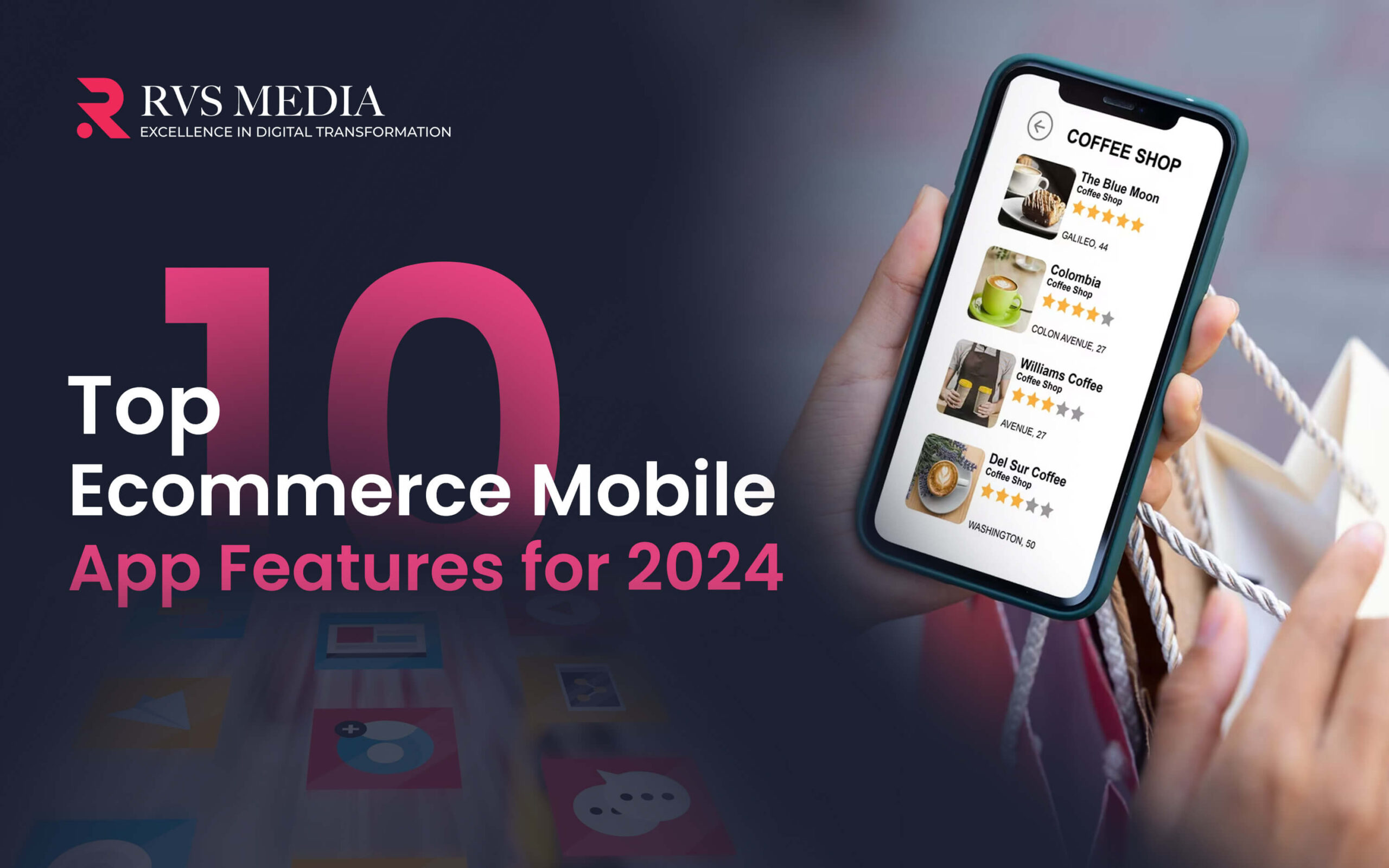Top 10 Ecommerce Mobile App Features for 2024
- Jul 15, 2024
- By Jasreet Kaur

It is said that change is the only constant thing in this world, and this is certainly true for eCommerce. As we move into 2024, mobile commerce is set to evolve significantly, making smartphones essential tools for online shopping. Statistics show that mobile commerce will be a major component of the eCommerce landscape in the coming years. To help you navigate this evolution, we present below a list of the ten must-have features for eCommerce Mobile App Features in 2024. Let’s explore these essential features and see how partnering with a mobile commerce agency can turn these ideas into strategies that boost sales and enhance your online presence.
Advanced Chatbots
Overview: Chatbots have come a long way from their rudimentary beginnings. In 2024, advanced AI-driven chatbots offer near-human interactions with customers. These chatbots can handle complex queries, provide personalised recommendations, and offer 24/7 support without human intervention.
Why It Matters: Advanced chatbots provide a high-quality user experience and significantly reduce customer service costs. Their instant responses can enhance customer satisfaction and retention.
Example: A chatbot that uses natural language processing to understand and respond to customer inquiries about product details, order status, and returns.

Single-Click Payments
Overview: Single-click payment solutions simplify checkout, allowing customers to complete transactions with just one tap. This feature minimise friction in the buying process and reduces cart abandonment, providing a seamless and stress-free experience for your customers.
Why It Matters: A seamless checkout experience is the key to converting visitors into buyers. Single-click payments can significantly boost conversion rates by reducing cart abandonment.
Example: Integration of payment systems like Apple Pay or Google Wallet that enable one-touch payments.
Effective Solution:
If you want to Learn more aboutHow to make your website more accessible and effective on mobile devices
Location-Based Ads
Overview: Businesses can deliver personalised ads based on a user’s physical location by leveraging GPS and geolocation technology. This approach helps target local customers with relevant promotions and offers, making them feel valued and essential to your business.
Why It Matters: Geolocation targeting increases the relevance of ads, can drive foot traffic to physical stores, or boost local online sales. It’s an effective way to reach potential customers near your business.
Example: A retail store sends exclusive offers to nearby users, encouraging them to visit the store.
Automated Loyalty Programs
Overview: Automation in loyalty programs allows businesses to manage customer rewards and retention strategies without manual intervention. Automated systems can track purchases, award points, and notify customers of their rewards.
Why It Matters: Loyalty programs foster customer retention and repeat purchases. Automation ensures that rewards are given consistently and that customers are always aware of their benefits.
Example: A coffee shop app that automatically tracks visits and rewards points that can be redeemed for free coffee or discounts.
AI-Powered Personalisation
Overview: AI algorithms analyse user behaviour to provide personalised shopping experiences. This includes tailored product recommendations, customised marketing messages, and adaptive content based on individual preferences.
Why It Matters: Personalisation enhances the shopping experience and increases the likelihood of conversions by showing users products and offers that match their interests and previous interactions.
Example: A fashion app recommending outfits based on past purchases and browsing history.
Augmented Reality (AR) Features
Overview: AR technology allows customers to visualise products in their environment before purchasing. This feature is handy for products like furniture, fashion, and home decor.
Why It Matters: AR enhances the shopping experience by allowing customers to see how products will look in real life, which can reduce return rates and increase customer
satisfaction.
Example: A furniture app lets users see how a sofa will look in their living room through their phone’s camera.
Voice Commerce
Overview: Voice commerce, or v-commerce, enables customers to purchase using voice commands through virtual assistants like Alexa, Siri, or Google Assistant.
Why It Matters: Voice commerce offers a hands-free shopping experience and appeals to users who prefer voice interactions over typing. It’s a growing trend that can capture a new segment of customers.
Example: Using voice commands to search for products, add items to the cart, and complete purchases.
Integrated Social Media Shopping
Overview: Social media platforms are increasingly integrated with ecommerce features. This includes shoppable posts, direct checkout options, and in-app purchasing.
Why It Matters: Social media is a powerful channel for reaching potential customers. Integrating ecommerce features allows users to purchase directly from their social media feeds.
Example: Instagram posts with product tags that link directly to the product page for easy purchasing.
Advanced Search and Filter Options
Overview: Enhanced search functionalities and sophisticated filter options help users find products quickly and easily, saving time and making their shopping experience more efficient and productive. Features like voice search, image search, and multi-layered filters are becoming standard.
Why It Matters: A robust search feature improves the user experience by making it easier for customers to locate products, which can lead to increased sales and customer satisfaction.
Example: A search bar that supports voice commands allows users to filter results by price, sie, colour, and reviews.
Enhanced Security Features
Overview: As online transactions become more prevalent, security is paramount. Advanced security measures include biometric authentication, encryption, and fraud detection systems.
Why It Matters: Ensuring the safety of customer data and transactions builds trust and reduces the risk of security breaches, which can damage your brand’s reputation.
Example: Using fingerprint or facial recognition for secure logins and transactions.

Conclusion
As we look ahead to 2024, these top 10 mobile eCommerce app features will be essential for businesses aiming to stay competitive and meet the expectations of today’s tech-savvy consumers. Whether you’re partnering with a mobile app development company or developing in-house solutions, features such as advanced chatbots, single-click payments, AI-powered personalization, and AR experiences will be key to enhancing user satisfaction, increasing engagement, and driving sales.
By incorporating these trends and technologies into your mobile ecommerce strategy, you can position your business for success in online retail’s dynamic and fast-paced world.
Why Choose RVS Media?
If your business is looking to implement these top mobile eCommerce features and stay ahead of the competition, partnering with a top mobile app design agency can offer major benefits.
As a leading mobile app development company, we specialize in providing cutting-edge, bespoke solutions tailored to your specific business requirements. Explore how our unique approach can help you reach your eCommerce goals.





